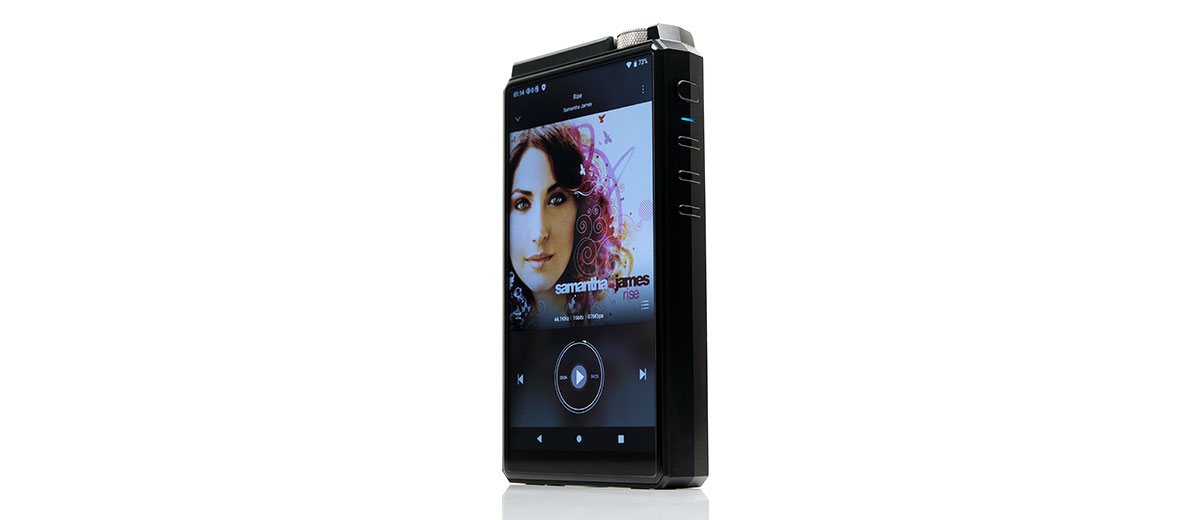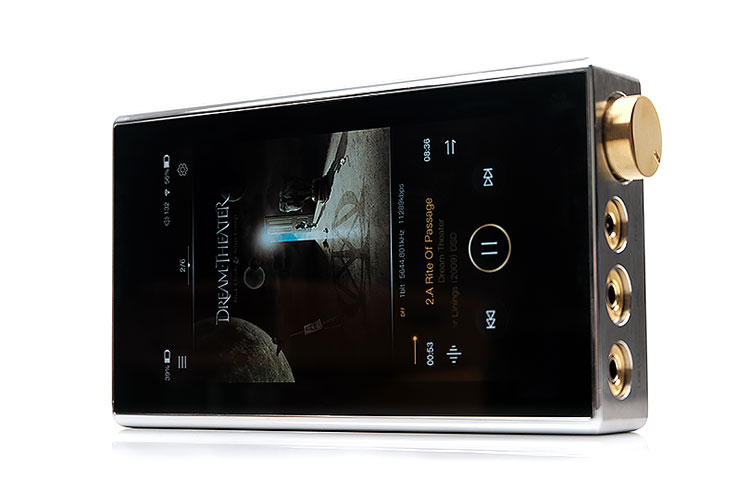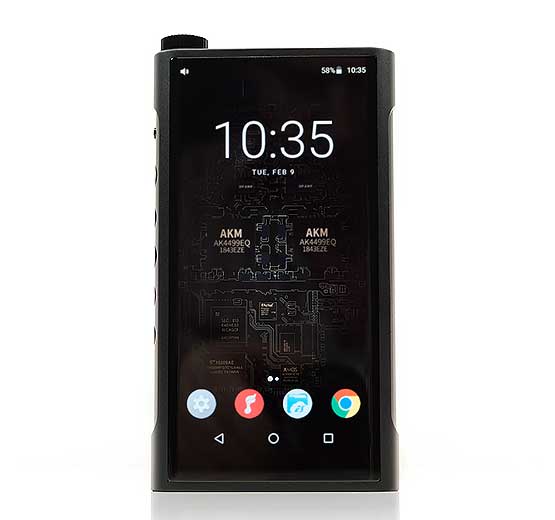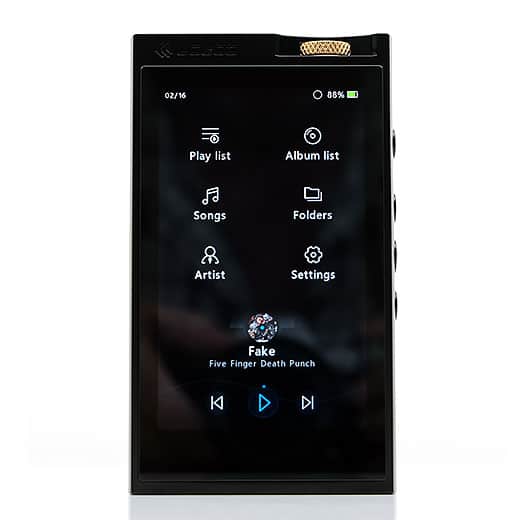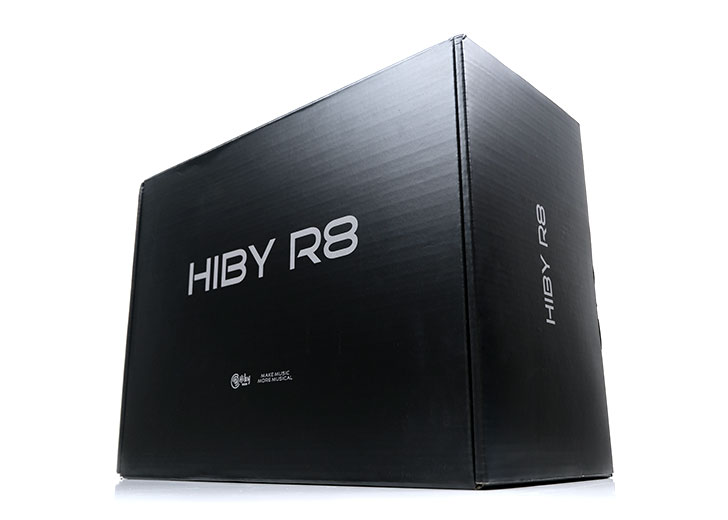Select Comparisons
(All side-by-side comparisons were completed using an Empire Ears Odin, Campfire Audio Solaris SE, Noble Audio Sultan, Meze Empyrean, and Dan Clark Audio Ether 2)
iBasso DX220 MAX
$1888
With a virtually identical price point and for some, an equal penchant for size, the DX220 MAX looms large as a direct R8 competitor. The only caveat is the limited edition aspect of the DX220 MAX whereas the R8 is a regular production run. iBasso units may be scarce to none in some regions.
Technical
The DX220 MAX uses a Sabre ES9028PRO chipset in a dual configuration which compares favorably for me with the dual AK4497 design inside the R8.
The R8 does have a slight edge when it comes to decoding capability at native DSD512 and PCM 32BIT/768kHz decoding compared to the DX220’s maximum PCM 32BIT/384kHz and native DSD512.
Both DAPs also offer BT5.0, bi-directional support (you can load HiBy Music onto the MAX if you wish for HiByLink), LDAC, and WiFi with streaming apps support. The MAX does offer a bit more memory at 128GB compared to just 64GB onboard for the R8.
MQA unfolding capability is higher at 16X on the R8 compared to 4X on the DX220 MAX. However, the MAX does have a bit more noise and jitter control with 5 femtosecond equivalent oscillators compared to just 2 for the R8.
The CPU is a bit of a bottleneck on the DX220 MAX. They have done very well in terms of maximizing it and balancing out the demand for its 5″ IPS 1080p screen for battery consumption.
However, the ARM Cortex chipset shows its age with a max clock rate of just over 1000MHz compared to the Snapdragon 660’s 2208mHz top rate. Despite both having 4GB RAM, the R8 AnTuTu numbers are much higher at 188k compared to just over 50k for the MAX. To be fair, the R8 does that to every DAP so the MAX is in good company.
Power Supply
Interestingly, implementation on both is a major selling feature with both isolating their digital and analog systems. The DX220 MAX does it a bit differently with 5 individual li-poly batteries, 1 (3.8V 4400mAh) for the DAC and the CPU, and 4 (4 x 900mAh 8.4V) for the amplification circuit in the form of a high-voltage battery pack.
The R8 uses a single 10000mAh 38Wh ATL custom battery with 4 individually isolated power circuits for the digital, DAC, preamp, and amp. It doesn’t have a completely isolated power supply like the DX220 Max but it also does not need individual DC and USB charging inputs for the DAC and amp.
Performance
Amplification on both is excellent but for different reasons. The DX220 MAX is a pure analog domain topology design including the potentiometer. The R8 amplification power circuit benefits from customized opamps and an individual power circuit but volume is still controlled in the digital domain.
Both the R8 and MAX have 4.4mm balanced and 3.5mm TRS unbalanced PO, however, in terms of LO the Max ditches the 3.5mm line out in favor of a 4.4mm balanced LO option only. The R8 offers both. The balanced LO of the Max, however, is a little stronger in terms of voltage at 4.4V compared to 4.1V on the R8.
When it comes to power both are top-notch. However, combined with superlative noise numbers the DX220 MAX is king with up to 7.5V into a 32Ω load or equal to 1758mW balanced output into 32Ω. The R8 can churn out just over 1W into the same 32Ω load with a slightly lower level of dynamic range at 114dB compared to 122dB on the MAX amp stage.
SNR is tighter at just under 117dB single-ended from the R8 compared to 122dB on the MAX but slightly noisier at 117dB compared to 125dB on the MAX. Indeed, the MAX is the quieter of the two with a blacker background with sensitive IEMs. It also has a bit more ‘welly’ for hard-to-drive headphones.
OS
A big advantage here for the R8 with a layer of Android 9 over a snappier CPU/RAM combination. The Max does well, certainly not as stop and start as when their Android 8.1 version came out on the DX220 in 2018, but it feels slow and stuttery compared to the speed of the R8.
Hopefully, iBasso can move on from the ARM Cortex chipsets in future DAPs as it is comparatively slow.
Both can now offer Google Play though the MAX does not have it preinstalled. You need to do that via APK Pure. Their 2 media apps are excellent but for different reasons. The PMEQ of the Mango app is the best in the business for me whereas the platform-wide MSEB DSP from HiBy is a fantastic user-friendly alternative.
Design
The aluminum R8 is big, but the CNC stainless-steel DX220 MAX is just bigger and heavier. I would still call the R8 a DAP and you do have a measure of control in the hand despite its 425g weight placing it just behind the Sony 1Z.
The same cannot be said of the MAX at 700g and about 30% bigger. It is transportable rather than portable, something reinforced by the need to use a wall wart plug for its analog design as well as a USB cable for the DAC side. The lack of physical buttons on the MAX also takes a little bit of portability away compared to the R8’s 3-playback button control system.
The R8 also managed to squeeze in a bit more screen real estate with a smaller bezel and a bigger IPS 1080p screen at 5.5″ compared to 5″ for the Max.
The R8 is brighter but in terms of dpi, the iBasso screen is a bit denser at 580dpi compared to 408dpi. Pixel density is much higher also on the MAX screen at 448ppi compared to 320ppi on the R8 screen.
In short, the R8 has more pop and brightness but the legibility of the MAX screen, especially smaller fonts, is a little easier on white backgrounds.
Tuning
You can break the differences between these two media players down into two very nuanced areas, timbre, and dynamic range.
The MAX delivers something a little more linear across the board with not a huge amount of emphasis on any particular part of the FR with our test gear. The R8 is a little richer, more forward sounding from the bass to the lower-mid, and wetter in its treble tone.
Neither are what I would call bass light but here is where that dynamic range comes into play because the R8 offers a bit more forwardness, body, and warmth but can sound a shade ‘softer’ sounding on our pairings.
The MAX sounds more linear than the R8 so you get a little less warmth and power but a bit more separation and also a perception of ‘pace’ and precision in the delivery. Thus, it can sound the more vibrant of the two despite not sounding so full on the low end.
The mids performance also differs a little for me with the R8 taking on a bit more of that AK4497 tuning I have heard before in some desktop DACs.
Vocals are even-harmonic and natural sounding with a slightly longer perceived decay but there is a comparative fade in vocal presence, possibly due to the dynamic range difference between the two or possibly the Sabre DAC tuning.
The MAX is a little more forward and a bit cleaner in its mids delivery as well as offering slightly more separation and air. There is a tiny bit more treble emphasis on the MAX which is where you get that cleaner timbre from but it is more nuanced than obvious.
I also perceive it as being a little drier than the R8 treble performance with our tested gear displaying a little less decay.
Overall, the R8 is fuller sounding on the low end and sweeter through the mids and treble. The MAX has a comparatively drier timbre but a tighter punchier low-end with an edge in overall dynamic range.
FiiO M15
$1299
Technical
Substantially cheaper at $1299, the M15 is FiiO’s flagship and it does share some similar traits to the R8 as well as some big differences. On the inside, FiiO also uses a dual-dac chipset implementation but it is the higher-rated AK4499 compared to the R8’s dual AK4497.
On paper, both have capable DAC performance numbers with support for 768kHz/32bit and native DSD512. However, the Snapdragon 660 SoC CPU/4GB RAM configuration on the R8 does outperform the FiiO’s Samsung Exynos 782/3GB by 70% on our AnTuTu numbers as well as offering up to 16X MQA decoding as opposed to 8X from the M15.
Aside from the headline DAC, both have dual-oscillation capability, 64GB onboard memory with a single microSD slot, and both offer BT5.0 with up to LDAC capability. The two DACs also offer access to even faster protocols with HWA being offered by the M15 and UAT from HiBy though both are quite niche.
Bi-directional support is included on both DAPs with USB-DAC/OTG input and output though the M15 does drop to PCM 384kHz/32bit output on OTG which is the same as the R8.
OS
Both DACs are WiFi equipped with Android platforms and access to Google Play (rooted OS) as well as APK Pure should you wish to use it. If you opt for the R8 you do need to download APK Pure as it is not installed out of the box.
The big difference here is the current version with the M15 using Android 7 and the R8 Android 9. I still think HiBy can and should make more use of the improvements in Android 9 as well as tweak the drop-down instant access functions. FiiO has made better use of its dropdown menu with gain, filter, and output power quick access options.
The R8 does have the better AnTuTu performance of the two DAPs and cool additional Android 9-specific features like double-tap to wake and rotation prompts. In any event, the R8 Android 9 platform is more future-proofed for APK compatibility than the M15.
Design
Neither are small DAPs but the FiiO is the more pocket or hand-friendly of the two being thinner and lighter by just over 100g.
The R8’s screen is better quality at 5.5″ compared to 5″, 1080p compared to 720p, and with better backlighting. The ppi on the two DAP screens is very similar at 320ppi on the R8 compared to 312ppi on the M15 so legibility is similar.
Both external housings have excellent physical control systems to go with snappy responsive multitouch screen actions. However, I do like the M15’s additional multi-function button below the main playback controls.
That brings up a further screen mini-menu with quick access to some useful features. The M15 also has a physical lock button which the R8 does not have.
The final design accent sees both DAPs move away from rocker dials or individual volume buttons and go with rotary dials or analog potentiometers at the top.
The R8 goes with a protected flat dial and the M15’s offers a protruding thicker dial that sticks out a bit. I prefer the protection of the R8 dial in all honesty and it is less aggressive in terms of current output.
Power
I also do not see quite as much information about power management from the M15’s 7300mAh battery compared to the R8’s independent power supply for each internal grouping such as digital, DAC, and amp.
The R8 battery is bigger at 10000mAh but without an official rating for balanced and unbalanced cycles from HiBy, it is a bit difficult to say which has a better battery life since test conditions and power ratings are different. What I can tell you is my approximate real-world usage of both was not that far off with the FiiO having maybe a slight edge by around 1 hour.
Amplification
The two DAPs have some excellent power specs with both offering some additional power via FiiO’s Over-ear headphones mode and R8’s Turbo Mode. The M15’s top-end under its mode comes to 800mW into a 32Ω mode, whereas the R8 goes even higher at just over 1W into the same load.
Both offer unbalanced and balanced amplification though the FiiO has the additional 2.5mm TRRS output which some might find useful. The R8 instead offers dedicated 4.4mm and 3.5mm line outs.
Performance
Both flagships have posted noise numbers of their respective “Over-Ear Headphones” and Turbo modes though the measurements are not that easy to compare directly.
The M15 specs generally offer a vague <1% into 32Ω for their over-ear mode THD+N rating which could be awful or amazing. In more detail, the M15’s THD+N is <0.0005% unbalanced at 32Ω without over-the-ear mode on and<0.0006% balanced on a 300Ω with the turbo mode on.
The R8 is rated at 0.00065% unbalanced and 0.00083% balanced, both of which measured at 32Ω and both of which have the more powerful turbo mode switched on. So, no direct comparison.
We also have to note that FiiO’s own version of turbo mode is some 20% lower in output power at 800mW compared to over 1W for the R8 so the numbers are broadly in line with each other given the difference in output power.
I would suspect the R8 non-turbo numbers, which they have not made public, are more competitive, since both had similar noise levels with both the Solaris SE and Noble Audio’s Sultan.
Tuning
We switched to the Empire Ears Odin and it is a fairly easy spot in terms of tonal differences between these two sources.
The M15 is going for a very neutral reference-like and articulate tonal quality whereas the R8 is a bit more rounded, warmer, and with a fuller sound. Treble on the M15 is a little further forward bringing in more ‘crispness’ to the M15 mids, especially female vocals and percussion which have a brighter tonality on the Odin compared to the R8.
The low-end is more neutral to the point where sometimes I wish it would just come out and play a bit more instead of remaining in the high-fidelity realm. It has fantastic detail and separation but lacks a little in terms of power and warmth.
No such problems with the R8’s bass response which extends deeper and sounds fuller. That carries a bit more warmth into the lower mids so timbre is richer, with a more rounded tone compared to the clean and precise mids performance on the M15 on the Odin.
You might also feel the M15 is a bit more mid-centric than the R8 due to the lighter low-end and certainly that higher treble presence will bring a bit more precision and perceived articulation in its delivery.
That can sometimes mean a bit of a harder edge on some vocals whereas the R8’s more relaxed treble retains a pleasant smoothness down into the upper mids timbre.
Lotoo PAW 6000
$1200
The PAW 6000 is the smaller sibling of the flagship Lotoo PAW Gold Touch and has a lot of shared features with its bigger brother. It also projects a very different user experience compared to the flagship R8.
Technical
The PAW 6000 uses a single AKM AK4493EQ implementation as opposed to the higher-end dual-DAC AK4497 design of the R8. It is actually the flagship PAW Touch that uses an AK4497 DAC implementation.
As such the decoding capability of the PAW 6000 is slightly lower for native DSD at DSD256 and the same for PCM at 768kHz/32BIT.
Native MQA unfolding is not an option on the PAW 6000 but it will playback alternative encoded formats within the MQA file shell such as FLAC and at a similar rate. The R8, however, will unfold up to 12X. Both can offer USB audio with USB-DAC and OTG digital audio functionality.
MQA is more relevant on the R8 as it is an Android platform with MQA-capable streaming apps. The Lotoo has its own OS and has no expandability so it works primarily on locally loaded audio files.
Aside from the decoding the PAW 6000 has poorer connectivity with a lower BT4.1, (bi-directional), and only WiFi for OTA updates. It has no onboard storage with only a microSD slot at the bottom for local file storage.
The R8 is more competitive for local storage with 64Gb onboard, a single microSD slot, and the capability for OTG flash drive expansion.
Battery life is rated at 15 hours on the PAW 6000 but it comes from a much smaller 5200mAh. It is nowhere near as powerful as the R8 though so the rough max 12-hour capability of the R8 is impressive.
OS
Both have different CPU setups but there is no point drawing a direct comparison with the quality of the CPU as their OS layers and demands are vastly different. The Lotoo OS is proprietary, very light in application, and very fast. This is a pure audio player.
Android 9 on the R8 is much more demanding with probably a lot more redundant processes outside of pure audio hence the Snapdragon 660 and 4GB. However, Android 9 is much more expansive with app capability, streaming, and proper WiFi connection whereas the Lotoo OS focuses purely on audio playback.
The PAW 6000 does have some good features with an excellent PMEQ and filter option suite but they are fixed or firmware dependent. With Android 9 on the R8, you can download just about anything you want for playback as well as obtain platform-wide DSP via MSEB.
Design
Well no question at 225g and about half the size, the PAW 6000 is a more pocket-friendly DAP. Of course, smaller means a smaller screen at 3.77″ using a 400 x 800 IPS capacitive touch LCD panel.
It works well within its tighter confines and the ppi does look a bit denser than the R8 so very legible. However, it does lack the visual pop of that bigger low bezel-width 1080p screen of the R8. when in full flow for album art.
The build quality of both is tight and professionally done. Both use a top panel rotary potentiometer that works in a similar fashion save for the aesthetic flashing LED ring motif on the PAW 6000.
Both have a standard set of playback and power controls on the right panel with the Lotoo offering more of a Sony DAP aesthetic compared to the slimmer buttons on the R8.
Performance
No question the R8 is the more powerful DAP at up to 1W into a 32Ω using its Turbo mode. The top-level numbers for the PAW 6000 are 300mW per channel into a similar 32Ω load and that is for both balanced and unbalanced outputs.
You will note also that the PAW 6000 uses shared 4.4mm and 3.5mm TRS outputs for PO and LO whereas the R8 has dedicated LO and PO for 3.5mm TRS and 4.4mm TRS.
Where the PAW 6000 really excels is the noise floor and hiss performance. Like its bigger brother, the PAW Touch, it is incredibly low at 0.00022% balanced and 0.00025% balanced for THD+N compared to the R8’s Turbo mode noise floor of 0.00065% and 0.00083%.
The SNR is around 4dB better also at 122dB and 121 dB balanced and unbalanced for the PAW 6000 compared to 117dB and 116.7dB for the R8.
The R8 does very well, to be honest, those are stand-up numbers for such a powerful output setting but for maximum silence and the blackest background for sensitive IEMs, particularly balanced, then the PAW 6000 is quieter.
Power
Before we delve into a more detailed rundown of the tonal differences I just wanted to bring up headphone performance and the advantage the R8 has over the PAW 6000. Using Dan Clark Audio’s Ether 2, you can tell right away the PAW 6000 does ok for current but voltage is just not as convincing.
By comparison, the R8 is vivid, dynamic, and expansive sounding whereas the PAW 6000 sounds ‘smaller’, narrower, and less holographic in its staging capability. The Ether 2 isn’t efficient and it can scale but I have always set the minimum for it at 1W and the R8 meets that requirement.
Tuning
The interesting follow-on from that is just how much vibrancy and resolution is retained when you drop down to efficient IEMs.
Sure, efficient IEMs will have a blacker background on the PAW 6000 with less hiss but put that aside or throw in a less efficient high-end IEM such as the Odin from Empire Ears and the presentation is way more engaging on the R8.
The bass performances on both are closer in terms of power and depth but it’s the mids and vocal performances that embody that R8 advantage. I would say the overall timbre is not hugely different in terms of harmonic balance but rather the additional textural detail the R8 can tease out is better.
Vocals suddenly have more character with more nuanced vocal traits standing out much better on the R8. The PAW 6000 sounds very good with excellent separation but is comparatively 2 dimensional about detailed texture.
That vibrancy and additional resolution come through also in their contrasting staging capability. The R8 throws out superior instrumental separation and a wider stereo field on the Odin, whereas the PAW 6000 is more center-focused, especially on female backing harmonized vocals.
Our Verdict
The R8 is possibly the most complete DAP on the market at the time of writing. That will mean different things to different people, it just depends on what you want your DAP to do.
For me, it is about covering the bases to a very high standard based on what we want from our media player. The R8 is the fastest no doubt, the cleverest in terms of DSP application, and the most up-to-date in terms of software. It has the best CPU out there right now to handle just about anything you can chuck at it.
The sound is mature, natural, and smooth sounding. This is a really easy timbral match with a wide range of monitors. It also has class-leading power also for headphones in turbo mode. The only real weakness is the noise floor for super sensitive IEMs. You might want to ‘ifi iEMatch the R8 if you insist on using hiss sensitive IEMs.
The DX200 MAX has an edge, granted, both in terms of dynamic range, lower noise floor, and output power. However, it is not a completely portable solution, rather, it is a stellar transportable player without equal. A player with a usage scenario that places it firmly on the desk for me whenever possible. The R8 stays in the hand, albeit in a firmly weighty presence.
And the packaging, oh my. It may be more on the superficial side to some but it is damn sexy, thoroughly useful, and well thought out. This is one very future-proofed and capable flagship player.
HiBy R8 Specifications
- Operating System Andriod 9.0
- CPU Model Snapdragon 660
- CPU Architecture Kryo260 Octa-core
- CPU Max Frequency 2.2 GHz
- GPU Adreno 512
- DAC AKM AK4497 x 2
- WiFi Support 2.4GHz, 5GHz
- Bluetooth Bluetooth 5.0
- USB USB 3.1
- Display Size 5.5 inches
- Colors 16 million true color
- Topology IPS
- Resolution 1920*1080
- PPI 400
- Touchscreen Multitouch
- RAM 4GB
- Internal Storage 64GB
- External Storage Up to 2TB + via 1 micro SD card
- Colors Aluminium alloy black
- Dimensions 143*81*20 mm
- Power Supply 5V⎓2A / 9V⎓2A
- Battery 10000mAh/3.8V
- Charge time <5H (0%-100%)
- Firmware Update OTA
- Text Size Adjustable
- Third-Party Apps Unrestricted access via Google Play and apk download

